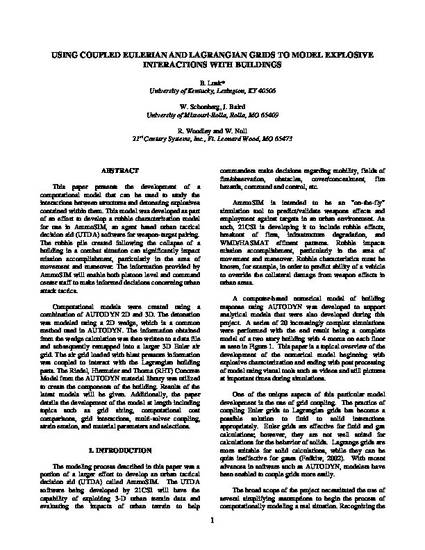
This paper presents the development of a computational model that can be used to study the interactions between structures and detonating explosives contained within them. This model was developed as part of an effort to develop a rubble characterization model for use in AmmoSIM, an agent based urban tactical decision aid (UTDA) software for weapon-target pairing. The rubble pile created following the collapse of a building in a combat situation can significantly impact mission accomplishment, particularly in the area of movement and maneuver. The information provided by AmmoSIM will enable both platoon level and command center staff to make informed decisions concerning urban attack tactics.
Computational models were created using a combination of AUTODYN 2D and 3D. The detonation was modeled using a 2D wedge, which is a common method used in AUTODYN. The information obtained from the wedge calculation was then written to a data file and subsequently remapped into a larger 3D Euler air grid. The air grid loaded with blast pressure information was coupled to interact with the Lagrangian building parts. The Riedel, Hiermaier and Thoma (RHT) Concrete Model from the AUTODYN material library was utilized to create the components of the building. Results of the latest models will be given. Additionally, the paper details the development of the model at length including topics such as grid sizing, computational cost comparisons, grid interactions, multi-solver coupling, strain erosion, and material parameters and selections.
21st Century Systems, Inc.
- Buildings,
- Blast,
- Structural Response,
- Computerized Simulation,
- Software Tools,
- Concrete,
- Debris,
- Symposia,
- Weapons Effects,
- Mathematical Models
Available at: http://works.bepress.com/robert-woodley/47/

The University of Kentucky and UMR co-authors would like to acknowledge 21st Century Systems, Inc. for providing the support that made this study possible.